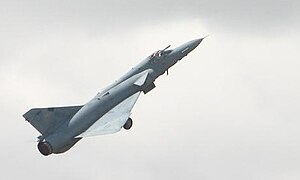Atlas Cheetah
| Cheetah | |
|---|---|
 |
|
| Role | Fighter aircraft |
| National origin | South Africa |
| Manufacturer | Atlas Aircraft Corporation |
| Introduction | 1986 |
| Status | Active with the Ecuadorian Air Force |
| Primary users |
South African Air Force (historical) Chilean Air Force |
| Number built | 38 (C), 16 (D), 16 (E) |
| Developed from |
Dassault Mirage III IAI Nesher |
The Atlas Cheetah is a South African fighter aircraft developed for the South African Air Force (SAAF), and currently operated by the Ecuadorian Air Force (FAE). It was developed as a major upgrade of the Dassault Mirage III by the Atlas Aircraft Corporation (later Denel Aviation) in South Africa and is based on the IAI Kfir. Three different variants were created, 16 dual-seat Cheetah D, 16 single-seat Cheetah E and 38 single-seat Cheetah C. The Cheetah Es were retired in 1992, and the Cheetah Cs and Cheetah Ds in April 2008, being replaced by the Saab Gripen. A limited number are still operated in South Africa as flight test aircraft.
The Atlas Cheetah programme grew out of South Africa's requirement for a modern fighter and strike aircraft in the 1980s. There was a need for more advanced aircraft to attain an edge over the ever more sophisticated Soviet aircraft such as the MiG-23 being supplied to Angolan and Cuban forces in action against South African forces in the Border War. Furthermore, the increasing cost of maintenance due to sanctions and the age of the aircraft used by the SAAF had to be addressed. The arms embargo imposed at the time by United Nations Security Council Resolution 418 prevented South Africa from purchasing new aircraft from other countries, thus making an upgrade of existing aircraft the only option. By this stage, the South African aviation industry had reached the level of technical capability to make a large and sophisticated upgrade possible, leading the SAAF to make the only possible decision: to extensively upgrade one of the existing types in service while an advanced indigenous fighter, the Atlas Carver, was under development.
At the time the SAAF's fast jet fleet consisted of Dassault Mirage III (EZ/CZ/BZ/DZ/D2Z/RZ/R2Z) and Mirage F1 (AZ/CZ) aircraft. Though the Mirage F1s were the most modern of the fleet, having been delivered from 1977 onwards, they were the primary element of South Africa's air defence and strike fleet and to withdraw them for an upgrade would have left an unacceptable gap in its air defence and strike capability. In addition there were already a few successful Mirage III upgrades from which to learn, such as the Israeli Kfir and Mirage III NG, so the SAAF's Mirage III fleet was chosen as the basis for the upgrade, to be known initially as Project Cushion.
...
Wikipedia
